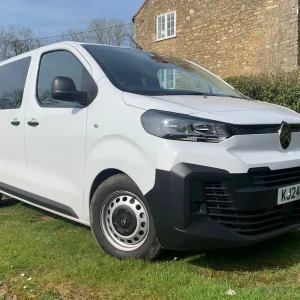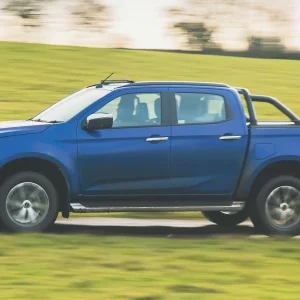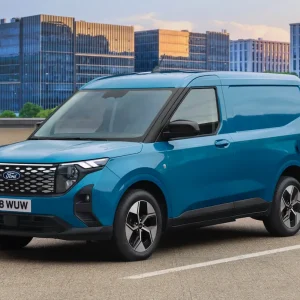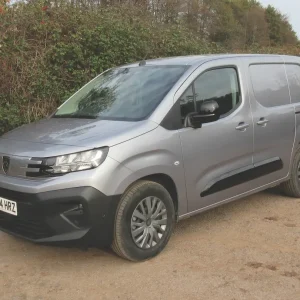Whatever happened to the hatchback car-derived van? Go back a few years and every mainstream manufacturer had one in its portfolio, with models such as Ford’s Fiesta Van marketed as handy runabouts. Today the genre has all but vanished.
Its disappearance is largely the consequence of the steady rollout of compact purpose-built vans such as Ford’s own Transit Courier. They offer more space and payload capacity than a car-derived van, and the load area tends to be much easier to access.
There is also the point that car-derived light commercials, though seemingly ubiquitous, seldom sold in vast numbers. So why persevere with a product that will never net you significant sales?
One or two manufacturers reckon that there is still mileage in the breed however. Car-derived models are usually fairly compact and therefore easy enough to park, and do not stick out like the proverbial sore thumb on a suburban driveway.
Leading the car-derived van charge at present is Toyota. In effect the heir to Vauxhall’s much-missed Astravan, its five-door Corolla Commercial comes with a clever twist which could give it an advantage in the marketplace.
It is a self-charging hybrid which can run on zero-emission battery power, but can switch to a combination of petrol and battery power as and when required. Its ability to charge itself means there is no need to go to the bother of plugging the battery into a charging point.
Derived from the Corolla Touring Sports 1.8 Hybrid car, the newcomer has undoubted environmental credentials. However the presence of a petrol engine dispels the range anxiety still often associated with pure battery-electric vans.
Designed and built in Britain at Toyota’s Burnaston, Derbyshire factory, Corolla Commercial comes with a single level of specification and quite a high one at that. So how did we cope with what is undoubtedly an unusual vehicle?

Load bay
Access to the 1.3m3 cargo area is by means of a rear hatch-type door plus a hinged door on each side with its windows covered with opaque film.
The car’s rear seats have gone, replaced by a timber load bed covered with a tailored rubber mat, and half a dozen cargo tie-down points. A steel half-height bulkhead topped off by a mesh grille is there to protect the occupants of the cab should the load slide forwards.
Unusually for a van these days, the rear door is glazed, and the window is equipped with a heater and a wash-wipe system. The hatch is supported by gas-filled struts.
The load area’s sides are protected against scratches and scrapes by a mixture of carpeting and plastic mouldings. Other features include a 12V power point.
Our van came with a tyre inflator/sealer rather than a proper spare wheel; not something we’re ever really happy about.
It helps to save weight though, and the absence of a spare wheel means that there is a big, empty space under the cargo bed. It is a good place to conceal power tools and other items you would prefer not to go missing.
Towing capacity is 450kg if the trailer is unbraked rising to 750kg with a braked trailer.

Interior and equipment
As we said earlier, the specification is high, with air conditioning, heated seats and a rear view camera (but strangely no reversing sensors, which are optional) all included in the deal. The driver and passenger can set the temperatures they require individually, electric windows and heated and electrically-adjustable exterior mirrors are fitted, and the electronic parking brake can be applied or released manually or automatically.
A handy USB socket sits next to the gear shift.
Controlling the multimedia system, including the DAB radio, the 8in touchscreen in the centre of the dashboard looks a bit cheap and nasty and appears as though it has been stuck on as an afterthought.
On the positive side, the heating and ventilation system is controlled by proper switches. This means that there is no needed to fiddle about with a touchscreen in order to discover how you increase the in-cab temperature, or put the booster fan on.
Smartphone integration is provided with Apple CarPlay and Android Auto along with Bluetooth compatibility.
In-cab stowage facilities include a roomy, lidded, but not lockable, glove box, a lidded bin between the seats which plays host to a 12V power socket and is accompanied by a couple of cup holders and a bin in each door. The driver’s seat and the steering wheel are height-adjustable, which should make it easy to achieve a comfortable driving position, especially given that the seat boasts an electrically-adjustable lumbar support.
Packaged under the Toyota Safety Sense banner, safety features include Pre-Collision System.
It warns the driver if the van is at risk of colliding with the vehicle ahead, primes the brakes to deliver maximum stopping power the minute the pedal is touched, and applies the brakes automatically if the driver fails to respond. It also reacts to wayward pedestrians and cyclists.
Drivers can always deploy Adaptive Cruise Control to help them maintain a safe distance from the vehicle in front.
Lane Departure Alert triggers a warning if you start drifting out of your lane on, say, a busy motorway. It also delivers steering input to help bring the van back onto the right path.
Installed too is Lane Trace Assist, which helps keep the vehicle centred in its traffic lane with light steering inputs. If both of these lane management systems are active then it seems unlikely that the vehicle will ever stray.
Vehicle Sway Warning will set off an alert if it thinks whoever is behind the wheel is nodding off, and advise them to stop and take a break.
Automatic High Beam switches automatically between high and low beam to prevent the Toyota’s LED headlights dazzling other drivers, while Road Sign Assist detects warnings and commands and highlights them. It also issues a caution if the prevailing speed limit is being broken.
All the usual safety systems are fitted including ABS with Electronic Brakeforce Distribution, Brake Assist, Vehicle Stability Control and Traction Control. No less than seven driver, passenger, and side airbags are installed, including a driver’s knee airbag, just in case everything goes pear-shaped despite all the aforementioned devices.
Disc brakes are fitted all round. Electrically-assisted rack-and-pinion steering delivers a 5.5m turning circle between walls shrinking to a 5.2m circle between kerbs.
Turning to the suspension, MacPherson struts are fitted at the front while a multilink set-up helps support the rear. Anti-roll bars are installed front and back.
Our demonstrator sat on 15in steel wheels decorated with plastic trims. They are shod with Bridgestone Ecopia EP150 195/65 R15 tyres watched over by a pressure monitoring system.
The van’s front and rear bumpers, door handles and rear-view mirror casings are all colour-keyed to match the rest of the body. Shame that there are no side rubbing strips to help prevent the (optional) metallic silver paintwork from getting scratched.

Powertrain
Developing 142Nm of torque at 3,600rpm, Corolla Commercial’s four-cylinder in-line 16-valve petrol engine works in conjunction with a 53kW/600v 163Nm permanent magnet synchronous electric motor/generator plus a lithium-ion battery. The combined package delivers 120hp at 5,200rpm.
Power is delivered by means of a single-speed Continuously Variable Transmission (CVT).
Press brake hold and the brakes will remain on when the transmission lever is in D for Drive, unless you press the accelerator pedal. That should stop you rolling backwards on an incline.
Driving
Keyless ignition is fitted. Put your foot on the brake pedal, press a button on the dashboard, wait until ‘ready’ appears on the instrument panel, ensure the electric parking brake is released, and off you go.
The van moves away from rest using the electric motor, which continues whirring away at low speeds or when Corolla Commercial is going down a gentle slope; unless the battery needs charging. If that is the case, then the petrol engine steps in immediately.
During normal driving the petrol engine plays the lead role while leaving the motor to act as a generator, and charge the battery. Accelerate hard and the battery’s power is added to that of the engine to give some extra impetus, cutting in and out smoothly with no jerking or hesitating.
Energy which would normally be dissipated when the van slows is recouped and pumped into the battery. To maximise this effect, push the gear shift lever to the ‘B’ setting when you are descending a steep hill.
Doing so increases the engine braking being delivered, in effect giving you the use of a heavy truck-style retarder.
Three different driving modes are on offer; Eco, Normal or Sport. You make your choice by flicking a switch just ahead and to the left of the shift lever.
The first two settings are fine for most daily tasks and deliver ample performance, although you may want to favour Normal if you are heavily laden or towing a trailer. Use Sport if you need to get past slow-moving traffic, or if you are in hurry.
Although there are times when the steering can feel a little dead, on balance Corolla Commercial rides and handles well.
In-cab noise levels are suppressed well aside from some droning from the tyres. Wind, tyre and suspension noise do of course become more noticeable when the van is running on battery power only.
Fuel economy is one of Corolla Commercial’s big plus-points.
Sticking almost exclusively to Eco or Normal, we returned anywhere from 54.2mpg to 67.4mpg according to the van’s on-board computer. This suggests that the WLTP (Worldwide Harmonised Light Vehicle Test Procedure) combined cycle figures quoted by Toyota are not too far adrift from reality.
They cite 55.6mpg to 61.4mpg.
Dashboard displays give you, among other things, the percentage of battery-only driving since you began your journey, tell you how much charge is left in the battery and encourage you to drive more frugally by giving you marks out of a 100.

Operating
Toyota has come up with a clever aftersales package to distinguish its light commercials from the competition.
Corolla Commercial owners can have their van maintained at a garage of their choosing for the first three years of its life.
After three years the initial 60,000-mile warranty expires, but they can benefit from an extra 12-month/10,000-mile warranty each time they have the vehicle serviced by an authorised Toyota workshop in line with its service schedule.
The warranty is provided at no extra charge up to a limit of 10 years/100,000 miles.
Five years’ worth of roadside assistance is provided from the date of first registration plus the guarantee of a service appointment at a Toyota dealership within seven days. If the guarantee is breached then the customer qualifies for a 50% cut in the workshop labour charge.
Toyota Corolla Commercial
Price (ex VAT) £21,640
Price range (ex. VAT) £21,640
Gross payload 425kg
Load length 1,558mm
Load width (min/max) 952mm/1,430mm
Load bay height 682mm
Load volume 1.3m3
Loading height 686mm
Rear door aperture 889mm x 1,041mm
Side door aperture 940mm x 724mm
Gross vehicle weight 1,835kg
Braked trailer towing weight 750kg
Residual value 30.3%*
Cost per mile 42.0p*
Engine size/power 1,798cc/120hp @ 5,200rpm
Torque 142Nm @ 3,600rpm
Gearbox 1sp
Fuel economy (combined WLTP) 55.6mpg
Fuel tank 43 litres
CO2 (WLTP) 115g/m
Warranty 10yrs/100,000mls
Service intervals 1yr/10,000mls
Insurance group 27E
Price as tested £22,165
* after 48 months/20,000 miles p.a – source – KWIKcarcost
Options
Metallic paint £525
Rivals
Dacia Duster Commercial
Price (ex. VAT) £13,995–£18,795
Load volume 1.6m3
Gross payload 486–503kg
Engines 90hp 1.0 petrol, 150hp 1.3 petrol, 115hp 1.5 diesel
Verdict: Having been recently-revamped, the highly-practical SUV car-derived Duster Commercial offers excellent value for money and the 4×4 variant is no slouch off-road either. It is good to see that it can now be ordered with a dual-clutch automatic EDC gearbox. Interior does tend towards the cheap and cheerful, but build quality is OK overall.
LEVC VN5
Price (ex. VAT) £48,900–£53,550
Load volume 5.5m3
Gross payload 699–830kg
Engines 90hp 1.5 petrol, 110kW electric motor
Verdict: Arguably Corolla Commercial’s nearest rival, the range-extended made-in-Britain VN5 is car-derived in the sense that it is based on the TX taxi. It is worth a look if you fancy something a bit different, but unfortunately it does not come cheap. LEVC’s light commercial line-up is limited as well, so you’ll have to look elsewhere if you need something bigger or smaller.
Toyota Land Cruiser Commercial
Price (ex. VAT) £34,036–£38,378
Load volume 1.6–2.2m3
Gross payload 488–756kg
Engines 201hp 2.8 diesel
Verdict: Based on the Land Cruiser car, and a rugged off-roader if ever there was one, the 4×4 Land Cruiser Commercial is just what you require if you need to haul tools and parts to fix equipment that can only be reached by driving up muddy and pot-holed tracks. For your money you get plenty of power and the choice of either a manual or an automatic transmission.
The Final Verdict
Design 8/10 – Attractive package that offers zero-emission driving with zero range anxiety
Cabin 8/10 – Comfortable working environment with a lots of goodies, like heated seats
Ride 8/10 – Smooth and supple, copes well with the UK’s dilapidated road network
Refinement 8/10 – Clearly well put together and in-cab noise levels are suppressed, for the most part
Load area 8/10 – Small with limited capacity, but accessible, protected against minor damage
Handling/performance 8/10 – Steering can feel a little dead, handling is dependable, with ample performance
Engine/transmission 8/10 – All parts work well together, with a seamless transition though practice is needed
Standard equipment 7/10 – Good selection with smart safety devices, but no spare wheel or reversing sensors
Operating costs 9/10 – Fuel-frugal, and Toyota deserves high praise for its aftersales offer
What Van? subjective rating 8/10 – Well-thought-out vehicle with precious few direct competitors
Overall Rating = 80/100





